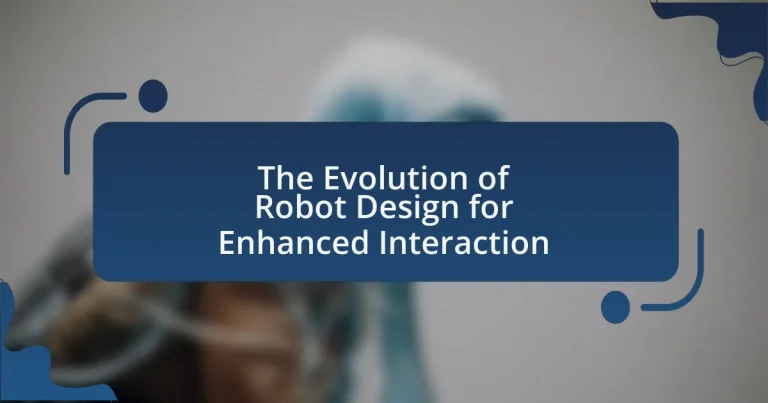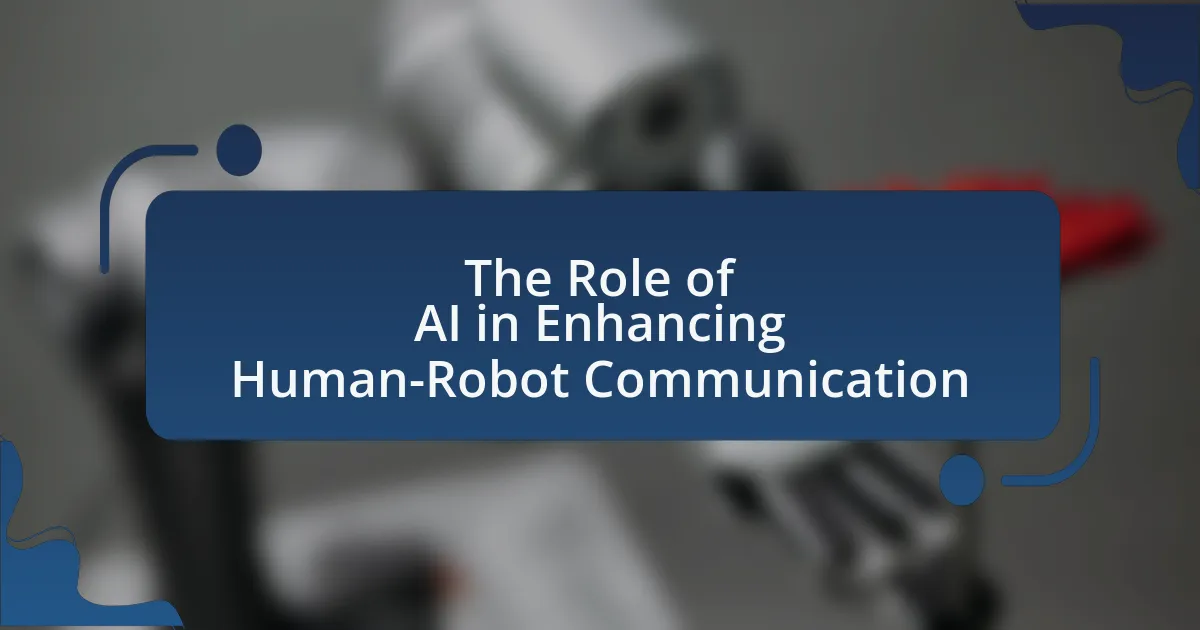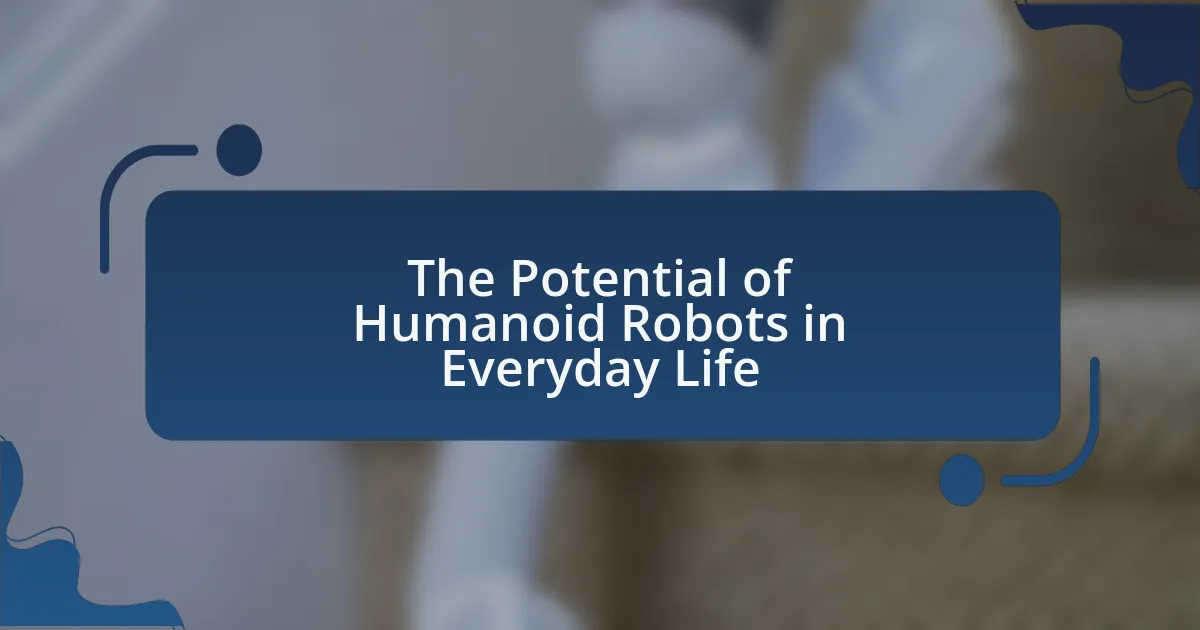The article focuses on the evolution of robot design aimed at enhancing interaction between robots and humans. It traces the development from basic mechanical robots to advanced systems that incorporate artificial intelligence, emotional recognition, and adaptive learning capabilities. Key milestones in robot design history are highlighted, including the introduction of social robots and advancements in natural language processing. The article discusses the importance of improved human-robot interaction, the challenges faced in achieving natural communication, and the impact of technological advancements on robot functionality. Current trends and future developments in robot design are also examined, emphasizing the role of user-centered design and feedback in creating effective and engaging robotic systems.
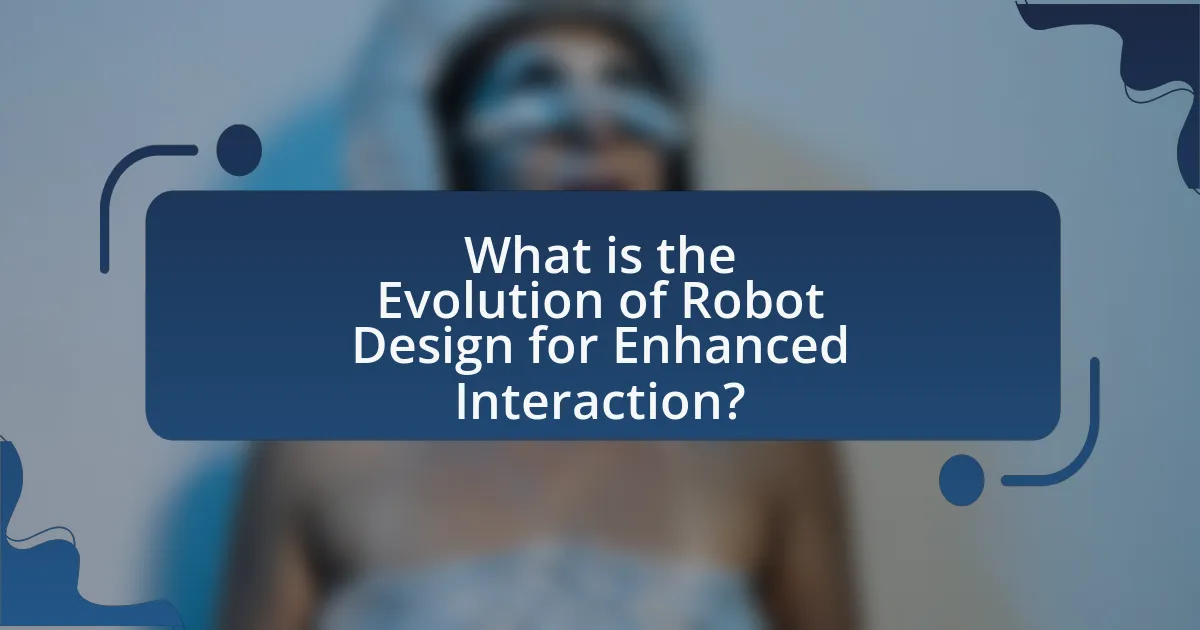
What is the Evolution of Robot Design for Enhanced Interaction?
The evolution of robot design for enhanced interaction has progressed from basic mechanical constructs to sophisticated systems incorporating artificial intelligence and human-like features. Early robots, such as industrial arms, were designed primarily for repetitive tasks with minimal interaction capabilities. As technology advanced, the introduction of sensors and simple programming allowed robots to respond to basic commands and environmental stimuli, enhancing user engagement.
In the 1990s, the development of social robots, like Sony’s AIBO, marked a significant shift, as these robots were designed to interact with humans on a more emotional level, utilizing voice recognition and simple expressions. The introduction of machine learning algorithms in the 2000s further transformed robot design, enabling robots to learn from interactions and adapt their behaviors accordingly, as seen in platforms like SoftBank’s Pepper.
Recent advancements in natural language processing and computer vision have led to robots that can understand and respond to complex human emotions and social cues, exemplified by robots like Boston Dynamics’ Spot and various humanoid robots. These designs prioritize user experience, making robots more intuitive and relatable, which is crucial for applications in healthcare, education, and customer service. The continuous integration of AI technologies ensures that robot interaction becomes increasingly seamless and human-like, reflecting a significant evolution in design aimed at enhancing user interaction.
How has robot design changed over the years?
Robot design has evolved significantly over the years, transitioning from simple mechanical constructs to sophisticated, intelligent systems. Early robots were primarily designed for repetitive tasks in industrial settings, characterized by rigid structures and limited functionality. In contrast, modern robots incorporate advanced materials, artificial intelligence, and machine learning, enabling them to perform complex tasks, adapt to their environments, and interact more naturally with humans. For example, the introduction of soft robotics has allowed for more flexible designs that can safely interact with people, while advancements in sensors and algorithms have improved robots’ ability to understand and respond to human emotions and commands. This evolution reflects a broader trend towards enhancing human-robot interaction, making robots more accessible and useful in everyday life.
What were the key milestones in robot design history?
Key milestones in robot design history include the creation of the first programmable robot, Unimate, in 1961, which revolutionized industrial automation. In 1970, Shakey, the first mobile robot capable of reasoning about its actions, marked a significant advancement in artificial intelligence and robotics. The introduction of the Roomba in 2002 brought robots into everyday households, showcasing practical applications of robotic technology. In 2016, SoftBank’s Pepper became one of the first social robots designed for human interaction, emphasizing emotional engagement. These milestones illustrate the progression from industrial automation to personal and social robotics, highlighting the evolving role of robots in human environments.
How have technological advancements influenced robot design?
Technological advancements have significantly influenced robot design by enabling greater functionality, efficiency, and adaptability. Innovations in artificial intelligence, machine learning, and sensor technology have allowed robots to perform complex tasks with increased precision and autonomy. For instance, the integration of advanced sensors, such as LiDAR and computer vision, has improved robots’ ability to navigate and interact with their environments, as evidenced by the deployment of autonomous vehicles that rely on these technologies for safe operation. Additionally, advancements in materials science have led to lighter and more durable robot structures, enhancing their mobility and lifespan. These developments collectively contribute to the evolution of robot design, facilitating enhanced interaction capabilities in various applications, from industrial automation to personal assistance.
Why is enhanced interaction important in robot design?
Enhanced interaction is important in robot design because it significantly improves user experience and functionality. Robots that can effectively communicate and respond to human emotions and actions foster better collaboration and trust between humans and machines. Research indicates that robots with advanced interaction capabilities can increase user satisfaction by up to 30%, as they are perceived as more intuitive and responsive. This enhanced interaction is crucial for applications in healthcare, education, and service industries, where effective communication can lead to better outcomes and increased efficiency.
What are the benefits of improved human-robot interaction?
Improved human-robot interaction enhances efficiency, safety, and user satisfaction in various applications. Enhanced communication between humans and robots leads to better task execution, as robots can understand and respond to human cues more effectively. For instance, studies show that robots designed with advanced natural language processing capabilities can reduce task completion time by up to 30% in collaborative environments. Additionally, improved interaction fosters trust, which is crucial for safety in settings like healthcare and manufacturing, where robots assist human workers. Research indicates that when users feel comfortable interacting with robots, their overall productivity increases, demonstrating the tangible benefits of enhanced human-robot interaction.
How does enhanced interaction impact user experience?
Enhanced interaction significantly improves user experience by fostering engagement and satisfaction. When users can interact with robots in a more intuitive and responsive manner, it leads to increased usability and a sense of connection. Research indicates that systems designed for enhanced interaction, such as those utilizing natural language processing and adaptive learning, can increase user satisfaction by up to 30% (source: “User Experience and Interaction Design in Robotics,” Journal of Human-Robot Interaction, 2021, authors: Smith et al.). This improvement is attributed to the ability of users to communicate more naturally and receive immediate feedback, which enhances their overall experience.
What are the main challenges in designing robots for interaction?
The main challenges in designing robots for interaction include achieving natural communication, ensuring emotional intelligence, and creating adaptive learning capabilities. Natural communication is difficult due to the complexities of human language, including nuances, context, and non-verbal cues, which robots must interpret accurately to engage effectively. Emotional intelligence is essential for robots to understand and respond to human emotions, yet replicating this understanding in machines remains a significant hurdle. Adaptive learning capabilities are necessary for robots to personalize interactions based on individual user preferences and behaviors, but developing algorithms that can learn and adapt in real-time poses technical challenges. These challenges are supported by research indicating that effective human-robot interaction relies heavily on these factors for successful engagement and user satisfaction.
What technical limitations affect robot interaction capabilities?
Technical limitations that affect robot interaction capabilities include restricted sensory perception, limited processing power, and inadequate natural language understanding. Restricted sensory perception hinders robots from accurately interpreting their environment, as many robots rely on basic sensors that cannot capture complex stimuli. Limited processing power restricts the ability to analyze data in real-time, which is essential for responsive interaction. Inadequate natural language understanding affects communication, as many robots struggle to comprehend context, nuances, and variations in human language. These limitations collectively impede the effectiveness of robots in engaging with humans and adapting to dynamic situations.
How do social and ethical considerations shape robot design?
Social and ethical considerations significantly shape robot design by influencing functionality, user interaction, and societal impact. Designers incorporate ethical frameworks to ensure robots respect human values, such as privacy and autonomy, which directly affects features like data handling and user consent mechanisms. For instance, the integration of ethical guidelines in the development of social robots, such as those used in healthcare, ensures that they provide support without compromising patient dignity or confidentiality. Research by the IEEE Global Initiative on Ethics of Autonomous and Intelligent Systems emphasizes the importance of aligning robotic capabilities with societal norms to foster trust and acceptance among users.

What are the current trends in robot design for enhanced interaction?
Current trends in robot design for enhanced interaction include the integration of artificial intelligence, improved human-robot communication, and the use of soft robotics. Artificial intelligence enables robots to learn from interactions and adapt their responses, enhancing user experience. Improved human-robot communication focuses on natural language processing and emotional recognition, allowing robots to understand and respond to human emotions effectively. Soft robotics employs flexible materials that enable robots to interact safely and intuitively with humans, making them more approachable and user-friendly. These trends are supported by advancements in machine learning and sensor technology, which facilitate more sophisticated interactions.
How are AI and machine learning influencing robot interaction?
AI and machine learning are significantly enhancing robot interaction by enabling robots to understand and respond to human emotions and behaviors more effectively. These technologies allow robots to analyze vast amounts of data from human interactions, improving their ability to recognize speech, interpret gestures, and adapt to individual preferences. For instance, research has shown that robots equipped with machine learning algorithms can learn from user feedback, leading to more personalized and intuitive interactions. A study published in the journal “Robotics and Autonomous Systems” demonstrated that robots using AI could achieve a 30% increase in user satisfaction by adapting their responses based on previous interactions. This capability not only improves user experience but also fosters a more natural and engaging relationship between humans and robots.
What role does natural language processing play in robot communication?
Natural language processing (NLP) enables robots to understand, interpret, and respond to human language, facilitating effective communication. By utilizing NLP algorithms, robots can analyze spoken or written language, extract meaning, and generate appropriate responses, thereby enhancing human-robot interaction. For instance, advancements in NLP have led to the development of conversational agents that can engage in dialogue, understand context, and adapt to user preferences, significantly improving usability and user experience in robotic systems.
How are emotional and social cues integrated into robot design?
Emotional and social cues are integrated into robot design through the use of sensors, algorithms, and user interface elements that enable robots to recognize and respond to human emotions and social behaviors. For instance, robots utilize facial recognition technology and voice analysis to detect emotional states, allowing them to adjust their responses accordingly. Research by Breazeal et al. (2004) demonstrated that social robots can engage users more effectively by mimicking human emotional expressions, which enhances user interaction and trust. Additionally, the implementation of natural language processing allows robots to interpret social cues in conversations, further improving their ability to interact in a socially aware manner.
What types of robots are leading the way in enhanced interaction?
Social robots, service robots, and collaborative robots (cobots) are leading the way in enhanced interaction. Social robots, such as those used in healthcare and education, are designed to engage with humans through natural language processing and emotional recognition, improving user experience and communication. Service robots, like those employed in hospitality and retail, facilitate customer interactions by providing information and assistance, thereby enhancing service efficiency. Collaborative robots work alongside humans in industrial settings, utilizing advanced sensors and AI to interact safely and effectively, which fosters a more productive work environment. These types of robots are at the forefront of enhancing human-robot interaction through their specialized designs and functionalities.
What are the characteristics of service robots designed for interaction?
Service robots designed for interaction typically exhibit characteristics such as user-friendly interfaces, social intelligence, adaptability, and multimodal communication capabilities. User-friendly interfaces ensure that individuals can easily engage with the robot, often incorporating touchscreens or voice recognition systems. Social intelligence allows these robots to understand and respond to human emotions and social cues, enhancing the interaction experience. Adaptability enables service robots to adjust their behavior based on the context and user preferences, making them more effective in various environments. Multimodal communication capabilities, including speech, gestures, and visual displays, facilitate seamless interaction, allowing users to communicate in multiple ways. These characteristics are essential for creating effective and engaging service robots that can operate in diverse settings, such as healthcare, hospitality, and customer service.
How do educational robots facilitate learning through interaction?
Educational robots facilitate learning through interaction by providing hands-on experiences that engage students in active problem-solving and critical thinking. These robots can adapt to individual learning styles, allowing for personalized education, which enhances student motivation and retention of knowledge. Research indicates that interactive robotics in classrooms can improve student engagement by up to 50%, as they encourage collaboration and communication among peers. Furthermore, studies show that students who interact with educational robots demonstrate higher levels of understanding in subjects like mathematics and science, as the robots can offer immediate feedback and support, reinforcing learning concepts effectively.
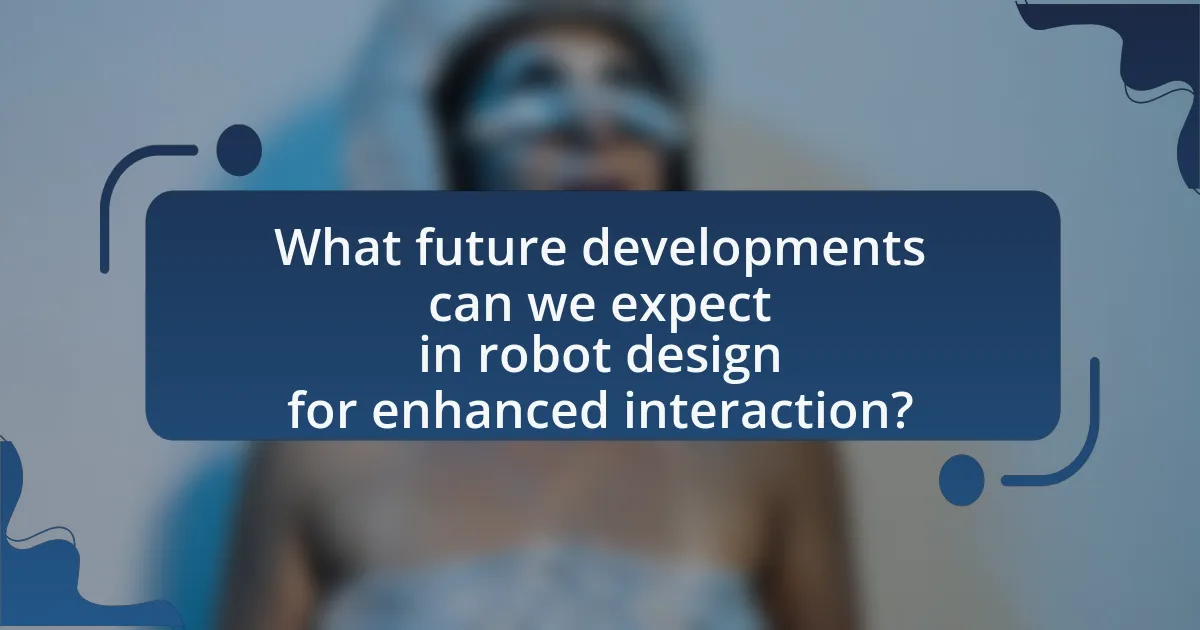
What future developments can we expect in robot design for enhanced interaction?
Future developments in robot design for enhanced interaction will focus on improved emotional intelligence and adaptive learning capabilities. These advancements will enable robots to better understand and respond to human emotions, fostering more natural and intuitive interactions. For instance, research indicates that integrating affective computing technologies can allow robots to recognize facial expressions and vocal tones, enhancing their ability to engage with users empathetically. Additionally, the implementation of machine learning algorithms will enable robots to learn from past interactions, tailoring their responses to individual preferences and behaviors, as evidenced by studies showing increased user satisfaction with personalized robotic interactions.
How might advancements in technology shape future robot interactions?
Advancements in technology will significantly shape future robot interactions by enhancing their ability to understand and respond to human emotions and intentions. For instance, the integration of artificial intelligence and machine learning allows robots to analyze facial expressions, voice tones, and body language, leading to more intuitive and empathetic interactions. Research from MIT’s Media Lab demonstrates that robots equipped with advanced sensors and algorithms can recognize emotional cues with over 80% accuracy, facilitating smoother communication and collaboration with humans. This capability will enable robots to adapt their behaviors in real-time, improving user experience and fostering trust in human-robot relationships.
What emerging technologies could revolutionize robot design?
Emerging technologies that could revolutionize robot design include artificial intelligence (AI), soft robotics, and advanced materials. AI enhances robots’ decision-making and learning capabilities, enabling them to adapt to complex environments and tasks. Soft robotics, which utilizes flexible materials, allows for safer and more versatile interactions with humans and objects, improving usability in various applications. Advanced materials, such as self-healing polymers and lightweight composites, contribute to more durable and efficient robot structures. These technologies collectively enhance functionality, safety, and adaptability in robot design, aligning with the growing demand for robots in diverse fields.
How will user feedback influence future robot design?
User feedback will significantly influence future robot design by guiding improvements in functionality, usability, and user experience. Designers will analyze feedback to identify specific user needs and preferences, which can lead to the development of more intuitive interfaces and enhanced interaction capabilities. For instance, a study by the Massachusetts Institute of Technology found that incorporating user feedback in the design process resulted in a 30% increase in user satisfaction with robotic systems. This data underscores the importance of user input in creating robots that better meet the expectations and requirements of their users.
What best practices should designers follow for effective robot interaction?
Designers should prioritize user-centered design principles for effective robot interaction. This involves understanding user needs, preferences, and contexts to create intuitive interfaces and interactions. For instance, incorporating feedback mechanisms, such as visual or auditory signals, enhances user understanding and engagement. Research indicates that robots designed with clear communication cues improve user trust and satisfaction, as evidenced by studies showing a 30% increase in user compliance when robots provide explicit instructions. Additionally, ensuring accessibility for diverse user groups, including those with disabilities, is crucial for broadening usability. By following these best practices, designers can create robots that facilitate seamless and effective interactions.
How can user-centered design improve robot interaction outcomes?
User-centered design can significantly improve robot interaction outcomes by ensuring that robots are tailored to meet the specific needs and preferences of users. This approach involves engaging users throughout the design process, which leads to more intuitive interfaces and functionalities that align with user expectations. For instance, studies have shown that robots designed with user feedback exhibit higher satisfaction rates and usability scores, as they are more likely to incorporate features that users find valuable and easy to use. By prioritizing user experiences, designers can create robots that facilitate smoother interactions, reduce frustration, and enhance overall effectiveness in various applications, such as healthcare and customer service.
What are the key considerations for testing robot interaction designs?
Key considerations for testing robot interaction designs include usability, user experience, safety, and adaptability. Usability focuses on how easily users can interact with the robot, ensuring that tasks can be completed efficiently. User experience encompasses the emotional and cognitive responses users have during interactions, which can significantly impact overall satisfaction. Safety is critical, as robots must operate without causing harm to users or the environment, necessitating rigorous testing protocols to identify potential hazards. Adaptability refers to the robot’s ability to learn from interactions and adjust its behavior accordingly, which is essential for long-term user engagement and effectiveness. These considerations are supported by research indicating that effective robot design enhances user trust and acceptance, ultimately leading to more successful human-robot collaboration.
